A beautiful and well-kept plot is a dream of any gardener and the owner of a private house. Today, designers can create a completely any landscape composition using both all known plants and quite exotic. Thuja colonum is a kind of Western Tui, which is an excellent decoration of the site, as it retains its bright green look throughout the year.
This is a coniferous evergreen plant, which has a charming aroma, a dense crown and unpretentious in care. Thuja Western Colon Feathed can be used absolutely for any garden composition, to create dense living hedges, beautiful trees with an unusual form of a crown, which is easily achieved due to the fit of the branches to the trunk providing a colonum shape.
In this article, consider the peculiarities of growing the Tui Colon-shaped, we give a description of the most popular varieties of this kind of evergreen tree. We also note the important moments of landing and caring for Tuya Western Colon's Affillage.
Morphological description and features of the Tui Colon's
Thuja Western Colon Featory is an evergreen coniferous plant, which belongs to the genus of vote. All the types of Tui are included in a large cypress family, which also includes juniper, cypress, cypressics and many others. On the territory of Russia, representatives of the Tui Colon Featory in nature are not found. Around the 16th century, this plant fell into Europe countries from East Asia and America, which are the natural habitat of the Tui Colon's Tui's habitat. Now, many varieties of Tui Western colonum are grown in gardens and household plots in temperate and northern latitudes.
The name of the evergreen tree "Tuya" has an ancient Greek origin. The scientific Latin name has an ancient Greek root, which in translation denotes "sacrificing, anonymous". This is due to the fact that some aromatic grades of the Tui in ancient times were used when conducting rituals to obtain a pleasant smell.
Today there are 6 types of Tui, among which there are trees and shrubs, having various forms of crown. You can select several forms of the Tui crown:
- colon's hair;
- pyramidal;
- binary;
- spherical.
All types of varieties fit perfectly into any landscape design, creating the most incredible compositions and bizarre forms. Among them are particularly popular with Thuja Colon's Three, with the crown of which you can create incredible figures.
Description Tui Colon's:
- Thuja colonum is an evergreen coniferous tree or shrub, which is distributed in nature in North America.
- In nature, this tree can reach a height of 20-25 m and is considered a tall representative of conifers, however, in the gardens and in summer cottages, a coloniary can grow only 10-11 m, and most often this plant reaches 2-3 m.
- The root system of Tui Colon's Powerful, but compact and does not grow much.
- The bark at the tree is light brown or reddish, peeling.
- Thuja Colon Featory is the most durable representative of this family and in one place can grow about 100 years.
- This type of Krohn tree has a pyramidal or colonum shape, hence the name of the Tui. In the width can grow approximately 1-1.5 m.
- The needles are very tightly adjacent to the trunk, located on horizontal branches. The needles of the thuu are represented by non-needles, like other coniferous trees, but tightly adjacent scales.
- In the summer of the needles, it has a dark green shade, and in winter - brown-green. Updated about once every 2-3 years.
- The scales are very small, only 2-4 mm in length.
- Flowers of this plant are not at all decorative, single one, located singly.
- After the end of flowering, a large number of fruits appear in the form of small cones on Tue Colon Feathed.
- The length of one bump is approximately 1 cm, in shape they are egg-shaped and have inside two seeds with wings.
- Thuja colonum is an ideal evergreen plant for urban landings, as this tree perfectly tolerates gaspace, dust and lack of oxygen.
- This variety is different and an excellent level of winter hardiness, can withstand frost to -36 degrees without shelter.
- Due to the dense crown, the coloniary is often used to create a living hedge and for windproof landing.
- The tree is perfectly pruning, however, the formation of the crown for the Tui coloniary is not necessarily, as it also keeps the shape of the column or cone.
- Thuja colonum easily tolerates a transplant and absolutely unpretentious to landing and care.
Variety of grades of Tui Colon's
Today there are a large number of types of Tui, which have a coloniary or pyramidal form of the crown. All these varieties were rapidly popular and love at gardeners, which use the coloniary to create incredible landscape designs. All varieties of Tui Colon's hair have compact dimensions, on average, 3 meters reach the middle. Consider a description of the most popular and common varieties of Tui Colon Featory.
- Variety "Brabant". It is a beautiful evergreen coniferous tree, which by 10 years can reach about 3-3.5 meters. Krone has a wide colonum shape, which in diameter can be about 1-1.5 m. This variety of the Tui colon-shaped is one of the fastest growing, for the year the tree can grow about 30-35 cm. The thuja of a rich green shade, which in winter Time becomes greenish-drow. Thuja Colon's Brabant is characterized by a good level of frost resistance. Flowering begins approximately in the spring, after which the bumps that have an ovoid shape are formed on the branches. The bumps in length reach 0.8-1.2 cm. Thuja of this variety perfectly transfers the haircut, the tree is not demanding to the landing site and to care. Ideal for creating dense creatures of alive hedges.
- Sort "Smaragd". The tree in height reaches 2.5 m to 10 years, the adult thua can grow to 3.5-4 m. Krone has a narrow colonum shape to 1 m in diameter. The needles of this tree has a bright green shade, which does not change even in winter. The branches are located very close to each other, which makes the crown dense. This variety of Tui Colon's feature has a very slow growth rate, as well as a rather capricious attitude to the soil and watering. Thuja Smaragd is rarely used to create a living hedge, since the upper part of the crown is not closed. Ideal for soliter landing or for conditional garden distinction or plot. This is a winter-hardy tree that can be grown in both open ground and container.
- The grade of the Tui Colon's "Column". The adult plant of the Tui Colon's Column reaches 5-6 meters, by 10 years the tree can be about 2.5-3 m. It is characterized by a narrow colonum crown, in the diameter of 1.3 m. Crown is formed by short branches, which are very tight to each other. . The needles has a rich green shade, which is practically not changing in winter. It differs quite quick increase - about 20 cm per year. The Tui of this variety has a good level of winter hardiness, the tree is not demanding to soil and tolerates the haircut. Thuy Column can be used to create live horses, as well as solitary and group landings.
- Grade "Holmstrup". Thuja of this variety in height can reach by 10 years 2 m, an adult plant can grow by 3-3.5 m. It is characterized by a narrow colonum-shaped crown, which is formed tightly adjacent to each other by branches. The color of the needles are dark green, practically does not change in winter. Crown is very compact and dense. Thuja of this variety is very frosty and unpretentious to soils, perfectly endures a haircut. It grows slowly, per year can grow only 10 cm. The ultimate height reaches only to 40 years. Used to create a living hedge, for single and group landings.
- Grade "Erhlo Ribbon". Thuja of this variety is a tree that by 10 years can reach a height of 2.5-3 m. It has a narrow conical form of a crown, which has a small density. Needle bright yellow shade. Trocery to the composition of the soil, used in contrasting landings.
- Variety "Aurea Pyramidalis". Thuja colonu-hair this variety in height can reach 5-6 meters, by 10 years it is possible to obtain evergreen beauty to 2-2.5 m high. It is distinguished by a narrow pyramidal crown, which over the years will grow significantly due to the fact that a tree appears several trunks. Crown consists of flexible, slightly twisted shoots. The variety is distinguished by demanding soil and watering. Refers to a group of frost-resistant varieties of Tui Colon's hair. Used to create solitary and group landings.
- Grade Tui "Aurssenzes". Evergreen tree grows on average high to 8-12 m, so it is most often used for very large-scale landings in parks and alleys. Croona Colon's, rather wide, is formed thick and dense branches. The needles have a dark green saturated shade with small white stripes. The variety is characterized by the attitude towards the landing and soil.
- Grade "Excelselza". This is a tall representative of the Tuy, which in height can reach about 9-12 meters. In width, the tree grows by 3-4 meters, so most often the Tui of this variety is used for landings in the parks and for the design of powerful large-scale landscape compositions. Crown has a colonum shape, which is formed by arcuate shoots directed upwards. The needles of dark green saturated color, very shiny.
Tui Colon's reproduction: the most common ways
Thuja colonum is one of the most popular evergreen trees for gardening. This is a beautiful and bright tree, you can do without any problems on your own at home, for this you just need to know the most common ways and features of their use. Thuja colonum breeds in the following ways: seeds and cuttings. Each option has its own rules, which it is important to adhere to to get a healthy and strong tree.
Seed reproduction of Tui Colon's
- This method of reproduction is rarely used, as the result is a plant without maternal signs and varietal differences. Most often, it is used by breeders to remove new varieties of the Tui.
- The young plant can only be obtained in 5-6 years.
- For the breeding of Tui, the coloniary in this way will be needed by freshly collected seeds that ripen to autumn.
- Previously need to be removed from the cones. For this, the collected ripe bumps are placed in a warm place for a while - it is necessary for the scales revealed. After that, the seeds are extracted.
- Before disembarking, seeds need to be soaked in water for about 10 hours.
- Next, the landing material needs stratification. This process can be carried out in natural conditions under the snow, and you can put seeds into the soil and put in the refrigerator.
- Seeds of Tui Colon's sings immediately into open ground to the depth of only 0.5 cm. From above, the garden is enough to sprinkle with sawdust of the coniferous tree.
- Sowing Tui is important to cover up from the sun and constantly loose and water.
- For the first season, the young seedlings of the Tui Colon Featory grow only at 7-8 cm.
- For the winter of crops, it is necessary to cover the huskiens and film.
- At a permanent place, the car's seedlings are planted on the third year, when young plants will grow up to 50 cm.
The propagation of the Tui colonum-shaped
- The reproduction of stalling is one of the most popular ways to obtain young saplings of Tui Colon's Tui.
- Planting material for landing is harvested in June. For this purpose, two-year shoots are about 20-40 cm long or annual twigs 10-15 cm long.
- Cuttings of the Thui cannot be cut, they are necessarily broken with a piece of a cortex, the so-called heel. After that, the location of the cut is processed by heteroacexin or charcoal.
- Before boarding, all cuttings can be placed for a while in a solution of the rooting agent, which will contribute to the fastest rooting.
- Planting planting material in greenhouses or greenhouse, you can also use containers.
- For the rooting of the cuttings, the soil mixture of the turf, peat and sand is suitable. Before planting the land, it is recommended to shed a weak solution of manganese.
- The cuttings rooted at a depth of about 1.5-2 cm.
- After landing, the entire seating material is covered with a film to maintain the required level of humidity and temperature.
- Thousands of Tui Colon's cuttings prefer very moistened air, watering the plants are not watered, but spray from the spray.
- After rooting the cuttings, we begin to ventilate and temper, after which the film is completely removed.
- In the last fall, the cuttings are covered with a snack and foliage, and with severe frosts they are covered with a film.
Preparation before landing Tui Colon Featory
Thuja colonum is considered one of the most popular trees among the gardeners, since this evergreen plant is distinguished by unpretentious and good frost resistance, which is important in the cultivation of plantings in the climatic conditions of our country. The cultivation of the Tui is not much difficulty even novice gardeners, it is enough to hold competent preparatory work. First of all, you need to purchase high-quality and healthy seedlings and find on your site the ideal place for planting a young tree.
Stage 1. Selection of varieties and saplings Tui Colon's
- The success of the proper landing of the Tui Colon's Aid is the choice of a suitable tree variety. It is important to choose an evergreen tree with a good level of frost resistance, especially if you are going to plant seedlings in a moderate climate.
- The seedling will also depend on the intended place of landing, where it is important to take into account the height of the adult plant. The approximate height of the adult Tui colonum is 2.5-3 meters.
- You can buy a co-colonum in specialized garden shops or nurseries who are professionally engaged in breeding plants.
- In the store you can purchase seedlings of different ages and different heights. It is best to buy young plants from 2-3 years old, they will be better suited.
- Before buying, be sure to check the state of seedlings. They should not be visible damage, dry or yellow branches of needles. The soil in the container should be moistened and clean. The plant also should not have signs of diseases or pests.
- Saplings with a closed root system can be purchased at any time of the year.
Stage 2. Selection of space and soil for landing Tui Colon's
- Thuja colonum prefers to grow on well-lit sunny places, however it is important that the direct sun rays be only part of the day.
- It is necessary that the site has a natural or artificial shading of young trees. Outdoor the sun of the needles can ship.
- The choice of landing space will also depend on the planned garden composition, for this you need to select seedlings of different heights.
- Also, when choosing a site, it is important to remember that the Thuja Colon Featory does not endure drafts, especially for young seedlings.
- The soil plant prefers a nutrient and fertile, consisting of a delicate earth, peat and sand, better than river. You can choose a place with a subline earth.
- Thuja loves wet soils, however, the roots of the roots are negative about the roots, so pick up a bit of sublime areas and places where there is no close occurrence of groundwater. You can take care before landing about a good drainage layer.
Planting Tui Colon Feathed in Outdoor Soil
- In moderate latitudes, it is recommended to plant the saplings of the Tui colonum-shaped seedlings, since the autumn landing does not guarantee the rooting of the young plant before the winter.
- Before boarding it is important to prepare the ground for landing. To do this, the selected area must be carefully overcooked and remove all nettle rhizomes and other weeds, as they can drown out the growth of the car. After that, peat and humus add to the soil, while natural fertilizer should not be fresh. It is allowed to use a monthly manure.
- All Tui colon-shaped in height reaches an average of 2-3 meters by 10 years, respectively, the root system is quite powerful. Landing pits should be 20-30 cm more than roots with an earthen room. Exemplary sizes should be as follows: 60-100 cm deep and width.
- When preparing landing holes, also consider how many seedlings will grow nearby. If you sit down a few thu, observe the distance of about 1.5-2 m. When creating a living hedge, the distance should be less than about 50-60 cm.
- At the bottom of each landing pit it is necessary to put a layer of drainage. This will allow you to remove moisture from the roots. As a drainage, you can use broken bricks, small stones or gravel.
- Next you need to prepare seedlings. The soil in containers are abundantly watered, after which the plant is carefully removed along with an earthen room around the roots.
- The soil mixture is poured on the drainage layer, and then placing seedlings.
- It is important to ensure that the root neck is slightly above the surface of the soil.
- Fall off the soils of the soil and very gently contend it with their hands, trying not to damage the plant.
- After planting, each plant must be abundantly pouring. One sapling should have about 2-3 buckets of water.
- The rolling circle must be closed to protect the root system from temperature drops. As a mulch, you can use sawdust, bark of trees, peat. It is important to ensure that the mulch does not cover the barrel and lower branches. From this they can start chant.
Agrotechnical cultivation of Tui Colon Aid: Secrets and Nuances of Care
The care of the Tuya Colon Featory does not require additional knowledge - it is exactly the same as care for other representatives of this kind. The main thing is to pay attention to the plant, especially in the first years after landing.
- Watering. Thuja colonum needs regular and abundant irrigation, since while drying the wood needle can begin to dry and shine. Young seedlings watered about 2 times in 7 days, using 2-3 buckets for each plant. In the period of growth, one colonum pouring is watered 1-2 times a week. Every seedling should have 1.5-2 water buckets. This plant is also very favorably refers to sprinkling, so at the spring landing it is recommended to spray the crown from the hose. If the summer is very roast, then you need to spray it twice a day, in the morning and in the evening, it will allow remove dust from the tree and sat down in moisture.
- Loosening and mulching. Regularly the soil around the seedlings should be loosened. It is necessary to do this at a depth of 10 cm. After each soil looser, it is important to add mulch to preserve moisture in the roots and protection against direct sunlight. The mulch use the bark of coniferous trees or peat. It is recommended to remove all weeds that can interfere with the full growth of seedlings.
- Falker Tui Colon's Aid. If the car's seedling colonum is planted into the nutritious and fertile soil, then it is enough to fertilize the soil 2 times the season. At the same time, the first feeding is brought only after 2 years. The first time feeds in the spring, while using nitrogen-containing fertilizers like ammonia nitrates. For the second time, the feeding is made at the end of summer, during this period you can use calcium and phosphoric fertilizers of the type of nitroammofoski.
- Tui trimming. Colon's Tui have a pyramidal or conical coxy shape, but this does not mean that since the landing of Krone, each plant grows perfectly smooth. There are varieties, which has a needle to flock and requires trimming. When buying it is important to inspect the seedling, usually these plants have several leading shoots, it is important to remove everything except one. Pruning should be carried out in the spring, removing all the dry and broken twigs. Forming a crown, it is allowed to cut the branches of a maximum of 1 / s length.
- Preparation for winter. Thuja colonum is a frost-resistant plant, but its growing branches can rush from snow and ice. That this does not happen, it is important to build a reliable shelter. You can put on a sapling wooden rails in the form of a shala and wrap them with burlap or white Loutrasil.
Photo of Tui Colon Feathed
Thuja colonum - evergreen beauty, which can be grown without problems in a cooler climate, than a natural habitat. It is not necessary to scare, difficulties with landing and care will not arise, since this plant is rather unpretentious if all the rules of preparation and landing are observed. As a result, you will get a beautiful and modern plot with gorgeous coniferous trees.

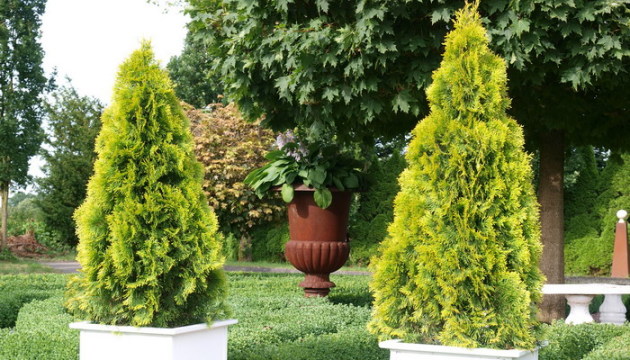
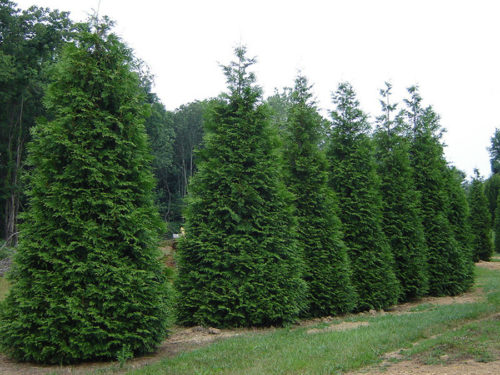
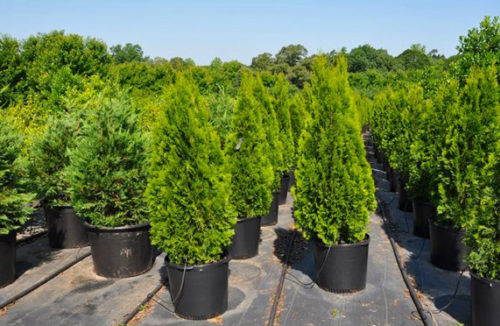
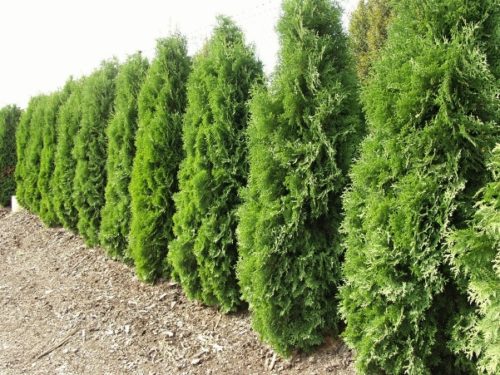
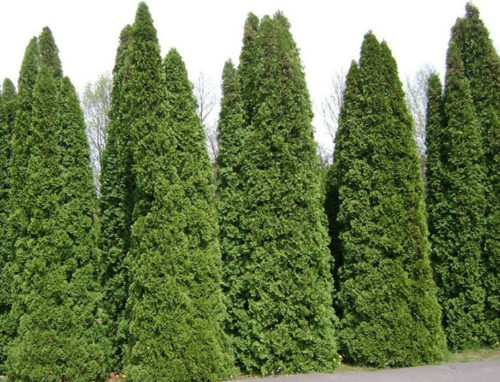
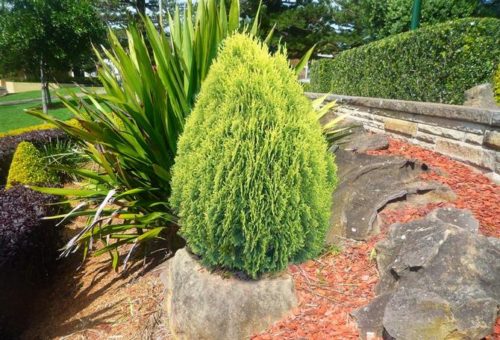
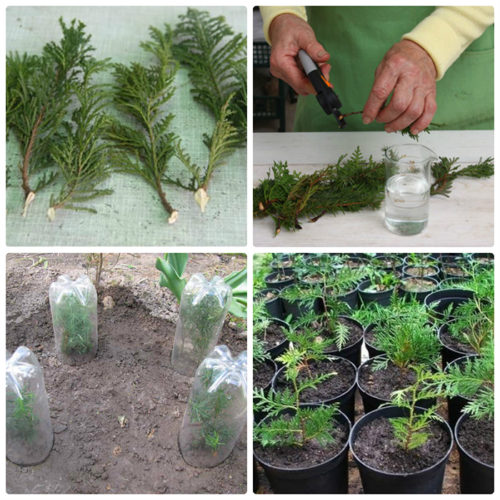
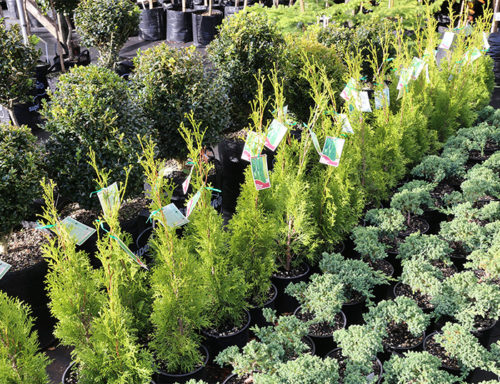

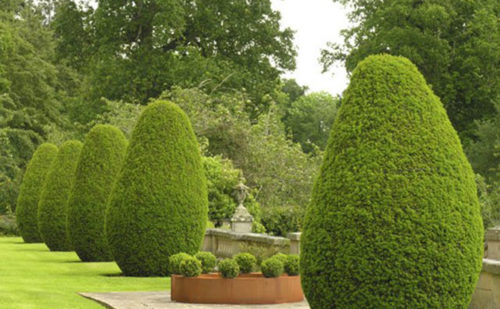
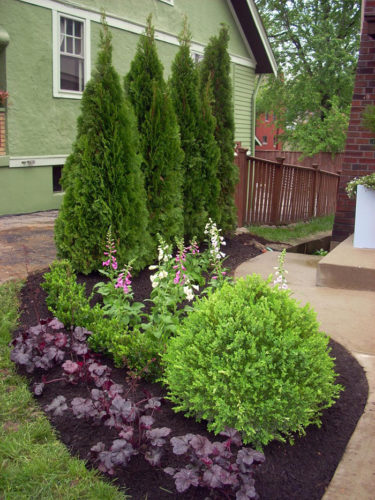
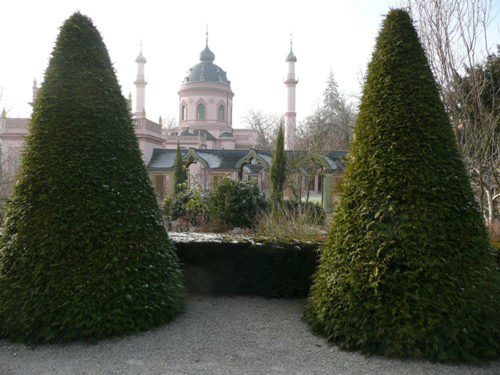
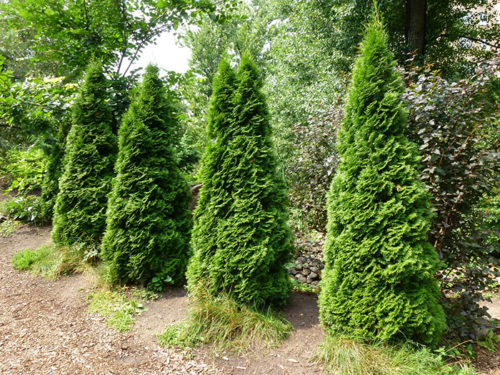
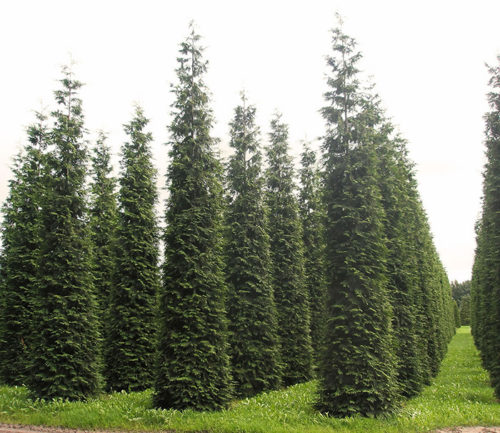

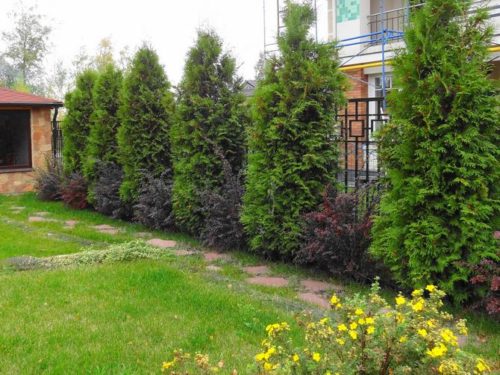












 Start a discussion ...
Start a discussion ...